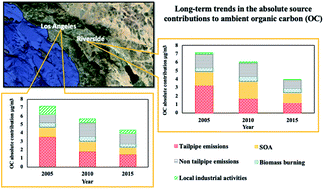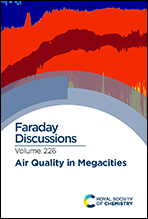Long-term trends in the contribution of PM2.5 sources to organic carbon (OC) in the Los Angeles basin and the effect of PM emission regulations†
Abstract
This study aimed to investigate the long-term variations in the contributions of emission sources to ambient PM2.5 organic carbon (OC) in central Los Angeles (CELA) and Riverside using the Chemical Speciation Network (CSN) database in the 2005–2015 period, during which several federal and state PM-based regulations were implemented to reduce tailpipe emissions in the region. The measured concentrations of OC, OC volatility fractions (i.e., OC1, OC2, and OC3), elemental carbon (EC), ozone (O3), sulfate, the ratio of potassium ion to potassium (K+/K), and selected metal elements were used as the input to the positive matrix factorization (PMF) model. PMF resolved tailpipe emissions, non-tailpipe emissions, secondary organic aerosols (SOA), biomass burning, and local industrial activities as the main sources contributing to ambient OC at both sampling sites. Vehicular exhaust emissions, non-tailpipe emissions, and SOA were dominant sources of OC across our sampling sites, accounting cumulatively for more than 80% of total OC mass throughout the study period. Our findings showed a significant reduction in the absolute and relative contributions of tailpipe emissions to the ambient OC levels in CELA and Riverside over the time period of 2005–2015. The contribution of exhaust emissions to total OC in CELA decreased from 3.5 µg m−3 (49%) in 2005 to 1.5 µg m−3 (34%) in 2015, while similar trends were observed at Riverside during this period. These reductions are mainly attributed to the implementation of several federal, state, and local air quality regulations targeting tailpipe emissions in the area. The implementation of these regulations furthermore reduced the emissions of primary organic precursors of secondary aerosols, resulting in an overall decrease (although not statistically significant, P values ranging from 0.4 to 0.6) in SOA mass concentration in both locations over the study period. In contrast to the tailpipe emissions, we observed an increasing trend (by ∼4 to 14%) in the relative contribution of non-tailpipe emissions to OC over this time period at both sites. Our results demonstrated the effectiveness of air quality regulations in reducing direct tailpipe emissions in the area, but also underpinned the need to develop equally effective mitigation policies targeting non-tailpipe PM emissions.

- This article is part of the themed collection: Air quality in megacities


 Please wait while we load your content...
Please wait while we load your content...